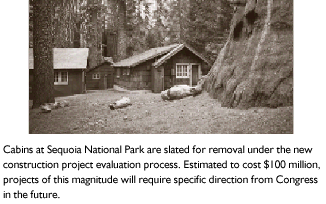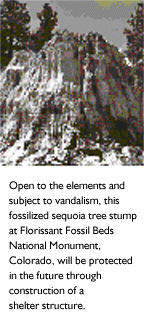![]() new look for the National Park Service line-item construction program suggests
that resource managers should pay more attention to construction projects
as potential natural resource management solutions. This program was reengineered
in 1995 and 1996, partly in response to congressional expressions of concern
that included cost overruns and a finding that "the priority system [used
by the National Park Service] is undecipherable."
new look for the National Park Service line-item construction program suggests
that resource managers should pay more attention to construction projects
as potential natural resource management solutions. This program was reengineered
in 1995 and 1996, partly in response to congressional expressions of concern
that included cost overruns and a finding that "the priority system [used
by the National Park Service] is undecipherable."
 In
the past, the National Park Service relied on the collective wisdom of
its senior managers in an informal process to set construction priorities.
In 1996, we adopted a new system that uses a formal process and a project
assessment team to rate and rank projects. Called choosing by advantages,
the decision-making process focuses on the importance of individual contributions,
or specific advantages, of each project, rather than the importance of
broad, abstract categories.
In
the past, the National Park Service relied on the collective wisdom of
its senior managers in an informal process to set construction priorities.
In 1996, we adopted a new system that uses a formal process and a project
assessment team to rate and rank projects. Called choosing by advantages,
the decision-making process focuses on the importance of individual contributions,
or specific advantages, of each project, rather than the importance of
broad, abstract categories.
 Last
July, the results of reengineering the priority-setting process were implemented
for the first time and numerous projects with benefits to natural resources
were evaluated. Most of these were projects to reduce or eliminate water
pollution, and sewage treatment projects were the most common. Upgrades
of such plants at Yellowstone and Glacier Bay national parks that would
eliminate discharges to sensitive waters, and had good information about
the discharges and the threats they pose, scored relatively high in the
"eliminates threats" category. Projects to remove septic systems that were
leaking near wetlands or significant water resources at Cape Cod National
Seashore and Acadia National Park also scored well. Two high-scoring projects
at Mammoth Cave and Wind Cave national parks dealt with preventing polluted
waters from entering cave systems. Many additional projects that would
benefit natural resource preservation in other ways also scored well.
Last
July, the results of reengineering the priority-setting process were implemented
for the first time and numerous projects with benefits to natural resources
were evaluated. Most of these were projects to reduce or eliminate water
pollution, and sewage treatment projects were the most common. Upgrades
of such plants at Yellowstone and Glacier Bay national parks that would
eliminate discharges to sensitive waters, and had good information about
the discharges and the threats they pose, scored relatively high in the
"eliminates threats" category. Projects to remove septic systems that were
leaking near wetlands or significant water resources at Cape Cod National
Seashore and Acadia National Park also scored well. Two high-scoring projects
at Mammoth Cave and Wind Cave national parks dealt with preventing polluted
waters from entering cave systems. Many additional projects that would
benefit natural resource preservation in other ways also scored well.
We learned some lessons here. First, if construction can provide solutions to natural resource problems, resource personnel should work closely with their facility manager as they design projects. Second, the definition of what constitutes a "construction" project is broader than many believe. If a project costs more than $500,000 and less than $20 million, it may be eligible for construction funding and it could be a resource rehabilitation project. Third, projects that have resource benefits of any kind will receive more credit if objective data are included in the package. Fourth, the system is explicitly open to resource protection projects and will give them a fair evaluation. Finally, the new process adds value to parks by favoring those projects that contribute to resource protection, high quality visitor experience, or improved park operations, including operating in a sustainable and environmentally responsible manner.
Other articles in the "New Horizons" chapter:
New program prescribed for wildfire management
Katmai takes on a dirty job and does it right
Collaborative decision making in the Pacific Northwest
Canada thistle control by insects
Building public support for natural resource management
Taking advantage of the Information Superhighway
Return to Front Page
http://www2.nature.nps.gov/pubs/yr_rvw96/chapter7/construc.htm
Last Update: 7 / 22 / 99
 .
. 